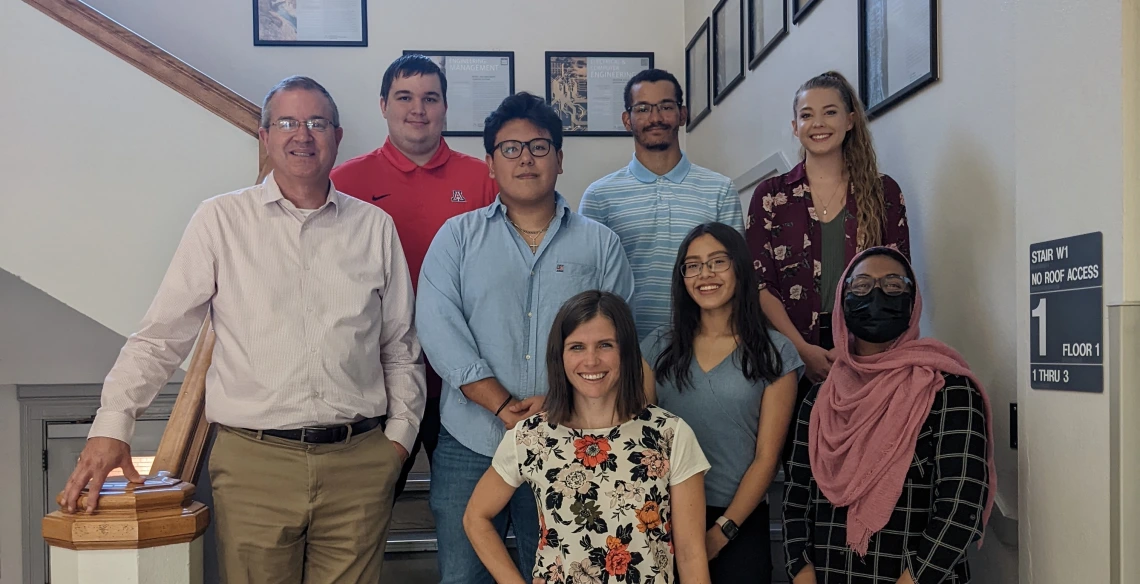REAL Work Sophomores Gain Research Experience
Students in the ENGAGED program get an early start in faculty laboratories and research groups.

REAL Work participants pose for a photo with Dean David W. Hahn (left) and ENGAGED director Noel Hennessey (center).
Some students go through their entire undergraduate experience without conducting research. But, in an April poster session, six College of Engineering sophomores presented their research on how to build stronger bridges, enhance cybersecurity in radio communications, and improve human beings’ quality of life.
The students were participating in the college’s Research, Engineering, Advocacy and Leadership (REAL) Work effort, part of the ENGineering Access, Greater Equity, and Diversity program, or ENGAGED program.
“We want to help students develop a sense of engineering identity in order to encourage them to persist in the engineering disciplines,” said ENGAGED director Noel Hennessey.
The program matches students up with research groups conducting work they are most interested in. When Noreen Qureshi said she wanted to research energy and renewables, Hennessey reached out to chemical and environmental engineering assistant professor Kerri Hickenbottom.
“And bada bing, bada boom, I was in a lab,” Qureshi said.
Kayma Konecny, an optical sciences and engineering student, is working in DK Kang’s lab on a blood testing device that is more affordable, smaller, and easier to use alternative diagnostic procedures. It pulls apart the samples so that anomalies are more easily detectable in imaging processes, using smaller amounts of blood. Konecny is helping make the device easier to use mechanically.
“DK has been an amazing mentor for me,” said Konecny, who received a funded position to remain in the biomedical engineering and optical sciences and engineering professor’s lab for another year. “I really think that this research, as well as the [ENGAGED] peer mentorship program, has kind of put me ahead.”
Software engineering student Glenn Sears conducted research with aerospace and mechanical engineering assistant professor Kyle Hanquist during his first year of college. Through the REAL Work program, he’s begun working with Gregory Ditzler, an associate professor of electrical and computer engineering, researching convolutional neural networks, a subset of machine learning.
Sears said he knew he had an interest in cybersecurity, but his time in REAL Work helped him narrow his focus and prepare him for what comes after undergrad.
“Doing research gets me some practical applications in the field,” he said. “I can go out to jobs and say, ‘Hey, this is what I’ve done.’ It can also be useful if I decide I’m interested in going down the graduate school route.”
Alejandro Ceballos Olivas and Jennifer Galvan-Garcia are working in Robert Fleischman’s lab in the Department of Civil and Architectural Engineering and Engineering Mechanics. They are modeling the performance of steel castings under different stress conditions to help develop standards for construction.
“You’re able to see how it is in real life and to apply some of what you learn in class to practical applications,” Ceballos said of the experience. “It’s a really great opportunity if you want to expand your skill sets and have a wider perspective.”
Mechanical engineering major Patrick Pinder-Newton, originally from the Bahamas, struggled during his first semester as an engineering student, especially in physics. He was considering changing his major when he heard about Summer TRACK. Another component of the ENGAGED program, Summer TRACK helps students complete engineering courses during the summer if they are not quite prepared for sophomore-level math and science courses by the end of their first year.
“I was like, ‘Oh, that’s a perfect opportunity to get back on track with my classes.’ But it also wasn’t just the classes. Summer TRACK involved a lot of going to companies, kind of building your identity as an engineer. That’s what I really love about that,” he said. “Now I’m staying here in engineering.”
After Summer TRACK, Pinder-Newton went on to join the REAL Work Program, through which he is conducting research with surgeon Dr. Daniel Latt, an orthopaedic surgeon, associate professor of orthopaedic surgery and biomedical engineering. The team is researching flatfoot, a condition where the ligaments of the foot don’t support its arch. It can cause foot pain, ankle pain and swelling so severe that some patients lose the ability to walk.
Pinder-Newton is working to improve a robotic gait simulator, which researchers can use to study how different movements and weights affect human feet.
“I think it’s valuable for an engineer to know how to do research and understand how it works,” he said. “I would definitely recommend the REAL Work program to other students. I honestly wouldn’t be in engineering if I hadn’t done it. It gives you an experience that you really wouldn’t get while you’re in college. Everything and everyone in REAL Work kind of helps you through the process.”

